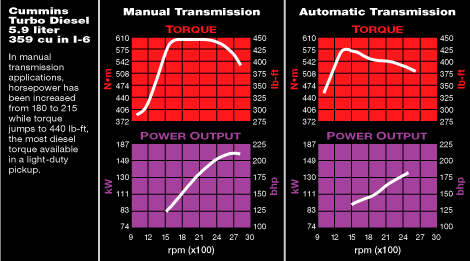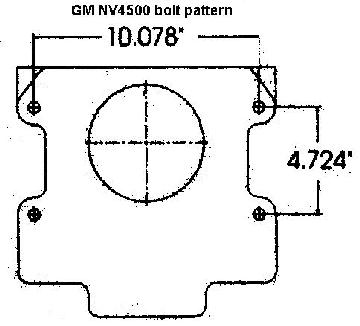
Specifications
Starting with the basic and moving down to the more detailed stuff, here we go!
Puff is a 1998 Dodge Ram 3/4 ton truck. She's an extended cab short bed which gives you the most interior room in the shortest wheelbase. I got her almost fully loaded. In fact the only options that weren't on there were ABS and an air dam. Reason is that Dodge dosen't have a reputation for the best breaks in the world and I don't need to compound the problem by having them release on my every time I hit a bump. As for the air dam, it would have gotten torn off while wheelin anyway, just a matter of time!
The engine is a Cummins 12-valve, which was only offered for a short while in the 98 model year. In Jan of 98 Dodge stoped using the 12-valve in favor of the potentially superior 24-valve.

As you can see, 215hp @ 2600 RPM's and 440 ft lbs @ 1600 RPM's isn't shabby but it's not enough in my opinion.... more on the on the mods page. Diesels as you may know are incapable of creating a significant vacuum thanks to their lack of throttle bodies so a vacuum pump is incorporated into the power steering pump. The brakes are hydraulicaly boosted off the power steering pump also.
The tranny is a New Venture 4500HD, which is connected to the engine with an aluminun SAE #2 bellhousing making tranny swaps almost a direct bolt in. While I haven't done so you I have had my eye on a 12-speed Eaton Fuller.
|
The HD model of the tranny has bigger input and output shafts. All NV4500's feature a cast iron case and aluminum shifter cover. This tranny is a constant mesh setup that fully synchronized, even Reverse! It is a top loader design so the lever operates the forks directly. These, along with the rails, are located in the cover. There is also a mechanism to prevent use of reverse while the vehicle is moving forward at any significant speed also located in the cover. Tapered bearings support the main and countershafts in the gear case as well as the drive gear. Pilot roller bearings in the drive gear hub support the forward end of the mainshaft. The mainshaft gears are all supported on caged type roller bearings while drive gear thrust reaction is controlled by a needle type thrust bearing located at the forward end of the mainshaft.The 450 LB-ft input rating is a continuous and conservative input rating for a long transmission life. It can easily withstand higher torque but transmission life will be reduced in proportionately. The tranny weighs about 250lbs. and takes 8 pints of Castrol Syntorqe. Syntorque is quite expensive but is the only lubricant slypery enough for these synchroes. Another nice feature of theis transmition is PTO ports on either side. |  |
||||||||||||||
The transfer case is a Nev Venture 241. It features a 2.73:1 low range and a synchronized high range engagement for shift on the fly 4wd. Mechanically speaking it uses the same housing as a Jeep's 231 and most of the guts are the same. However it has a beefed up input shaft, and the gear reduction system is larger. The drive chain is also slightly heavier. There is also a source of vacuum on the case which is used to engage/disengage the front axle's vacuum disconect. More on that coming up. the input torque rating on this case is 1028 ft. lbs. and the fluid capacity is 4.7 pints of ATF. I use a synthetic, Mobil 1 to be exact.
On to the stuff that impresses all fourwheelers... THE AXLES!
The rear axle on my truck is a Dana 80 Hybrid axle. It's a hypoid type full floter with a GAWR of 8500 lbs. The fluid capacity is 10.1 pints in case you care. The axleshafts themselves are 35 splines and have a 1.50" diameter. The ring gear has an 11" diameter and can be fitter with a LockRight. An ARB or a Detriot for a Dana 70 can be used if the ring gear mounting holes are drilled and taped.
The front axle is a Dana 60, also a full floating hyphoid type, but are only a 30 spline 1.31" diameter. The ring gear diameter is 9.75" and the axles only hold 7.8 pints. Also the axle capacity is a mere 4850 lbs, which is inadequate for wheelin a Cummins equiped rig (the engine weighs 1000 lbs by itself). An ARB is highly recomended as the only locer to be used in the front because Dodge uses a vacuum disconect to disengage the front axle. If an auto locer is used up front the front driveshaft is always spun in 2wd but from the few people I've talked to there are no i'll effects to handling. Other available traction aids are Lockright, TrueTrack, Detroit, and Auburn limited slip.
My axles are running 3.54:1 gears and are fully open. My breaks up front are 12.5"x1.5" using a single 3.38" piston full floating caliper in front and a 13.0 x 2.5" drum in back. My truck also features a RWAL which I still haven't figured out how to disable without loosing my speedometer. There is a hall effect sensor mounted to take readings off the rear end's ring gear to take speed readings and also to send a signal to the rear wheel antilock.
The rear suspension is leaf spring with 3" wide, 60" long leaf packs witch feature both overload leavs and an auxiliry pack in overload situations. The front is meanwhile a coil sprung 4-link similar to the TJ's (I think all these platforms share control arms).